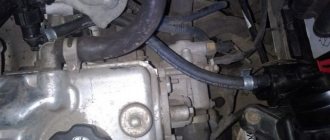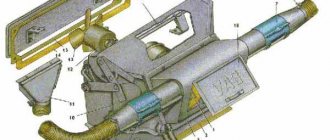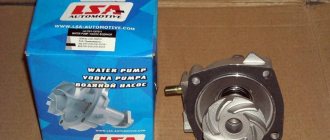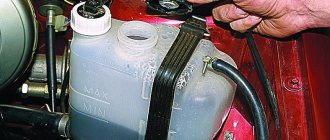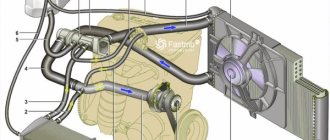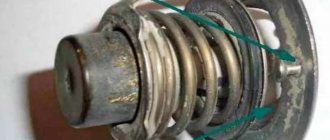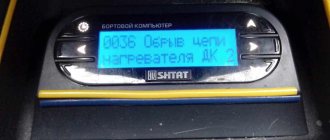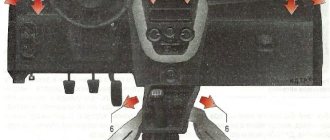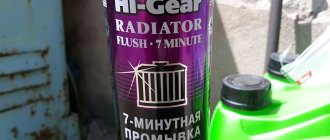| The heater does not heat or does not work, the coolant level each time drops below the MIN mark, the engine temperature does not rise to operating temperature, or the engine overheats? The causes of all these ailments are improper operation of the engine cooling system (ECS). We learn to identify and eliminate the causes of poor performance of the LADA Grant SOD. |
Elements of the Lada Granta cooling system
- stove heater radiators;
- electric pump;
- engine;
- throttle assembly;
- thermostat;
- antifreeze temperature sensor;
- overheat indicator;
- viscous fan drive coupling;
- fan;
- radiator cap;
- radiator;
- expansion tank cap;
- expansion tank;
- water pump;
- drain valve of the lower circuit.
And also, pipes of the Lada Granta cooling system, metal clamps - ties.
Thermostat
The cooling device on the Lada Grant is the main link in the chain. Performs the function of a valve that redirects the flow of antifreeze from a small to a large circle. When the operating temperature is below 94°, the thermostat is in the closed position. The liquid circulates in a small circle without “entering” the radiator.
New thermostat
According to this movement pattern, the heating of the liquid occurs many times faster. When the antifreeze heats up, the valve opens slightly, starting circulation in a large circle into the water jacket line.
Most often, a thermostat malfunction is associated with its boiling or jamming due to overheating. The part cannot be repaired; it must be replaced with a new, serviceable one.
Related link:
Replacing the ignition module on the Lada Grant. Tips from repair experts
Water pump (pump)
Forces antifreeze to circulate through the jacket (system). Structurally, the pump is located inside the engine, closer to the gas distribution mechanism (GRM). Moreover, it has a common drive with the timing belt.
Water pump
The average service life of the pump is 80 – 85 thousand km. Due to the frequent violation of regulations by the driver, the purchase of cheap analogues instead of original spare parts, the part wears out prematurely.
Radiator and fan
Cooling radiator
The radiator is designed to cool antifreeze. The standard fan also performs this function, but only after the operating temperature reaches a critical level of 100°.
Fan
How quickly the fan activates depends on the health of the temperature sensor. The latter monitors the degree online and sends the readings to the electronic engine control unit (ECU) to adjust the operation of the mechanisms.
Failure of the sensor leads to boiling of the engine. Many car owners have encountered this problem.
Connecting hoses and water jacket
Hoses serve as a link, connecting all mechanisms to each other. Frequent malfunctions are associated with a violation of the integrity, tightness of the system, and low levels of antifreeze.
Cooling system pipes
The water jacket is designed to circulate antifreeze throughout the system and remove excess heat. Damage to the jacket will result in water hammer inside. When using antifreeze, the risk of water hammer is 27% lower, in contrast to distilled water.
Expansion tank
The fluid level in the cooling system decreases and increases depending on the actual temperature. To compensate for the amount of antifreeze, an expansion tank is pre-installed in the design of the cooling system.
Expansion tank
The accessory material is heat-resistant polymer. On the outer surface there is a gradation of scales: minimum, maximum, recommended level. The tank is sealed with a sealed lid with a gasket.
When the pressure in the system reaches 1.1 kgf/sq. cm, the valve opens and releases the excess. The pressure in the system stabilizes. When the temperature of the liquid drops, to prevent vacuum, the inlet valve opens and replenishes the missing amount of air. How much antifreeze is in the Lada Granta cooling system: 7.5 liters up to about and 8.0 liters up to the recommended level.
Related link:
How to make an armrest for a Lada Granta yourself. Recommendations from professionals
Is the absence of an engine temperature sensor a cost-saving measure?
An interesting point is the absence of an indicator on the instrument panel indicating the fluid temperature and engine condition. As the developers themselves say, this indicator does not correspond to the price category of the car and is too expensive for it.
The solution to the problem was to install a special light bulb on the panel, which lights up red in case of overheating. If the system is working properly, in this case, the fan automatically turns on, and the problem is resolved without driver intervention.
Despite everything, the Lada Granta, whose cooling system is very well thought out, works well and rarely causes breakdowns. This is a proven car, albeit of a budget class.
Cooling system Lada Granta - 8 and 16 valves, with and without air conditioning
| Name | Peculiarity |
| The engine cooling system (hereinafter referred to as SOD) of the Lada Granta family is completely identical to the Lada Kalina | Heater radiator, single-pass, low resistance, aluminum, brazed, high efficiency |
| The radiator is built into a small circuit, unlike previous generations | |
| The thermostat has one valve, not two, as was previously the case | |
| The thermostat controls the flow of antifreeze through the radiator | |
| The interior heating system has been improved by removing more heat from the heater radiator | Increased flow of antifreeze through the radiator at a small circle of rotation |
| One-way passage pattern instead of two-way | |
| Aluminum pipes are flat instead of cylindrical | |
| Soldering is used at all stages of articulation | |
| No chance of airing | Changing the angle of inclination of the antifreeze supply/return lines |
| Improved aerodynamic performance | |
| Fine tuning of engine operating temperature | |
| Increased operational efficiency due to | Changes in ignition timing |
| Economical fuel consumption mode |
Why do they get hotter?
In addition to the fact that the modern engine itself heats up more, it now has neighbors that further heat up the situation. For example, catalytic converters, which on most modern cars are located in close proximity to the engine.
Air conditioner
also contributes to an increase in temperature: its capacitor not only generates heat, but also impedes the passage of air to the engine radiator. In addition, dirt (fluff, leaves) inevitably accumulates between these heat exchangers, preventing normal cooling. In addition, in order to reduce the overall weight, the radiators became thin, and the antifreeze filling volumes were almost halved - in normal mode the cooling system works normally, but there is practically no emergency reserve.
Automatic transmission
- another heat source that contributes to an increase in temperature under the hood.
Turbocharging
also increases the temperature. Moreover, if the engine is equipped with intercoolers, which also heat the engine compartment.
This is interesting: Cleaning the crankcase ventilation system of VAZ 11183, VAZ 21116 and VAZ 11186 Lada Granta engines
Checking the radiator for leaks
The diagnostic process is not at all complicated; we carry it out ourselves, and if you don’t have free time, visit a service station to have the work performed by professionals.
Checking the radiator from the engine compartment side
- We place the car within the perimeter of the repair area, on the inspection hole, and open the hood.
- From the engine compartment side, we inspect the surface of the radiator for drips and traces of antifreeze (antifreeze) leakage.
- We carry out similar actions from under the bottom of the car;
- We inspect the antifreeze supply/return lines, upper and lower circuits.
The most common places for depressurization: corners around the perimeter, joints, ties with clamps.
How to drain antifreeze from the cooling system of a Lada Granta
- The hood is open, the car engine has cooled down to a safe temperature so as not to damage the skin.
- We unscrew 6 screws from under the bottom and remove the oil pan protection.
- Unscrew the drain plug in the lower circuit of the radiator.
- At the same time, unscrew the drain plug on the wall of the cylinder block. We substitute the container.
Related link:
Adjusting the clutch pedal on the Lada Granta. Expert advice on self-replacement
Unscrew the plastic drain plug of the radiator tank
Note to the driver!
The Lada Granta version has 8 valves. Place the container for testing below the ignition module, under the cylinder block (nut at “13”).
In the Lada Granta 16-valve, we first dismantle the starter, since it prevents free access to the plug. If you do not remove the starter, antifreeze will flood the part, temporarily rendering it unusable.
- After the liquid is completely drained from the water jacket, screw in the drain plugs. Fill in new antifreeze in a volume of 7.5 liters to about or 8.0 liters to the recommended average level.
Causes that can be identified and some that can be eliminated
Almost any element of the cooling system can become a starting point for overheating under certain circumstances. The most common reasons that lead to engine overheating can be several:
Radiator problems
Minimal - contamination with dust, poplar fluff, leaves. To fix it, just clean everything. More costly are internal contamination of the radiator, which can occur due to scale from the water used, as a result of the use of various sealants. In some cases, they can be cleaned, and in others, only a new radiator can be installed. In rare cases, the radiator may be punctured; sealants are used to eliminate the leak, or replacement is carried out.
Coolant leakage due to system depressurization
Obvious leaks in the cooling system most often occur due to cracks in the hoses, loose clamps, wear of the pump seal, malfunction of the heater valve, radiator and other reasons. This may occur due to the use of low-quality coolants, sudden changes in ambient temperatures, forcing water barriers..
Inoperative thermostat or valve
You can determine by carefully feeling the lower part of the car's radiator (or hose) when the engine is hot. If it is cold, then the thermostat is to blame for the engine overheating. In this case, we go to the store, buy a new thermostat and change it.
Pump (water pump) failure
It may not work or work inefficiently, leading to poor circulation through the cooling system.
Faulty fan
It may not turn on due to a broken sensor, electric motor or clutch, or simply a loose wire. The impeller does not spin and does not cool the radiator.
Combustion chamber seal failure
Usually it is a consequence of previous overheating, when head gaskets burn out, cracks appear in the head and cylinder liner, and deformation of the mating plane of the head or block. This reason can be determined by the coolant leaking from the barrel, the rapid increase in pressure in the cooling system immediately after startup, as well as by the characteristic oil-water emulsion in the crankcase. But it is usually possible to establish specifically what is causing the leak only after partial disassembly of the engine.
How to remove air from the cooling system of a Lada Granta
There are several effective ways to bleed air from the system.
Purge using a pump
Method No. 1
- We move the stove heater lever to the “Maximum” position (car interior). Be sure to follow basic safety measures and place wheel chocks under the rear wheels.
- Unscrew the valve cover, having first removed the decorative trim.
- Using a screwdriver, loosen the clamp on the throttle body fitting and remove the rubber pipe..
- Unscrew the cap on the expansion tank
- Through a gauze bandage, blow air through your mouth in the direction of the expansion tank.
It is important not to overdo it, as you can start a new portion of air again.
Method No. 2
- We warm up the car to 40 - 45°, turn off the engine.
- Unscrew the throttle clamp and remove the hose.
- If liquid leaks out of the hose, put it back on, otherwise wait until the air comes out.
- We assemble the structure in reverse order.
One time is not always enough to remove air. We repeat the procedure as necessary.
Method No. 3
- We drive the front wheels of the car onto a hill so that the highest point in the cooling system is the “plug”.
- We twist the cap on the expansion tank and the cap on the radiator.
- We start the engine, it runs at idle speed.
- We warm up the car to an operating temperature of 40 - 45°.
- As soon as the antifreeze level begins to decrease, we replenish the missing amount.
- We repeat the procedure until the maximum amount of plug comes out.
- Screw the lids on.
Related link:
Lada Granta automatic: owner reviews
An air lock in the system can not only reduce the efficiency of the stove heater, but also negatively affect the operation of the engine as a whole. After the blockage is cleared, systematically inspect the equipment.
Consequences of overheating
When overheating occurs, two areas of the engine usually suffer. First
— sealing the gas joint. Deformation of the cylinder head and, to a lesser extent, the block itself leads to loss of joint tightness. Moreover, a long engine, for example an inline six-cylinder, suffers more than a short one, which has a head of only two cylinders (opposite Subaru).
Second zone
- cylinder-piston group. With slight overheating, the matter may be limited to slight scuffing and loss of elasticity of the piston rings (especially if the oil scraper rings are cast iron). When there is severe overheating, the pistons are literally “smeared” onto the cylinder walls, and the rings are tightly clamped in the piston grooves.
In both cases, the motor will require disassembly, diagnostics and expensive repairs.
How to flush the cooling system on a Lada Grant
Violation of the deadlines for replacing the fluid, the purchase of cheap analogues contributes to the formation of sediment in the line and clouding of the antifreeze.
Due to the loss of chemical and physical properties, the water jacket of the power unit is subject to corrosion and peeling.
A constantly elevated operating temperature is the first sign of contamination, deposit formation, or thermostat malfunction. The manufacturer recommends cleaning the lines every 50,000 km. Replacement of antifreeze after 75,000 km.
The volume of the Lada Granta cooling system is 8.0 liters.
Cleaning methods
- external;
- internal.
In the first case, all dirt is removed from the outside using water pressure and adding detergent. In the second case, washing is carried out inside with special chemicals.
If the flushing does not give a positive result, then we replace the standard radiator with a new one, since an excess amount of fossils has accumulated at the bottom and the corrosion process has begun.
Distilled water
We use distilled water
You can get distilled water in several ways:
- buy at a pharmacy;
- melt clean snow;
- let tap water stand for six months.
The washing process is as follows:
- We place the car on the inspection channel, unscrew the fastenings of the oil pan protection.
- We twist the drain plug of the system and grind off the antifreeze. First, unscrew the cap from the expansion tank and relieve pressure.
- After the waste has been drained, tighten the plug and pour 8.0 liters of distilled water into the system.
- We start the engine, run it at medium speed for several minutes, and turn it off.
- We repeat steps 2 and 3. As soon as the water comes out with a pure color, the washing is complete.
- Refill with new antifreeze. Next replacement after 75,000 km.
Soda, acid and vinegar
Rinsing with improvised means
Mix the indicated ingredients in the percentage ratio: 25 / 50 / 25, add a liter of water. We drain a similar volume from the system, add the “potion”, leave the car motionless for 6 – 8 hours, preferably overnight.
Related link:
Replacing the air filter on a Lada Granta with your own hands
In the morning we grind off the waste, rinse the system once, and fill in clean antifreeze.
Special means
The process is similar to the one described above. We carry out in compliance with basic safety rules. You can purchase additives at any specialized auto store or car market.
Our recommendations
It is easier to overheat the engine in extreme heat than in cold weather. Therefore, the higher the temperature outside
, the more carefully you need to handle the engine - avoid sudden acceleration and braking. Do not forget to brake the engine: combustion of the air-fuel mixture does not occur, and the coolant circulates more intensively through the system.
Remember about radiator cleanliness:
on some models it is justifiable to wash it at every maintenance. But usually it is enough to give him water treatments once every two to three years.
Complete coolant replacement
required at least once every 60,000–80,000 km. By this mileage, antifreeze usually begins to lose its properties. And its condition affects not only the temperature regime, but also the life of the main components of the cooling system.
Some auto component manufacturers produce thermostats with different opening temperatures. For example, for the popular 1.6‑liter Renault K4M engine there are thermostats at 82 degrees, and there are at 86. Four degrees is a significant difference. For cars with very intense thermal conditions (due to both design and operational reasons), it is better to choose a thermostat with a lower operating temperature.
And don't forget to service your car regularly
and troubleshoot problems that arise. Then you won’t have to croak on the road due to overheating and frantically search for the tow truck’s phone number.
Typical malfunctions of the Lada Granta cooling system
| Malfunction | Diagnostics | Remedy |
| The fluid level is below the permissible norm in the radiator | Inspection of the highway for integrity | Topping up |
| The motor is overheating | Thermostat is stuck | Replacement with new one |
| No pressure in the cooling system of Lada Granta | Channel clogging, depressurization | Replacing the water pump |
| The electric fan does not turn on when the temperature limit is reached | Checking the integrity of the electrical circuit and fuse Checking the fan circuit of the Lada Granta | Prevention, replacement with new ones |
| Whistle from under the expansion tank cap | Inspection | Replacement |
| The motor takes a long time to reach operating temperature | Inspecting the antifreeze level | Adding fluid, replacing the thermostat with a new one |
| The temperature sensor systematically shows false data | Inspecting the electrical circuit, measuring the sensor resistance | Replacement with new one |
| No circulation in the main line | Inspection through the expansion tank with the engine running | Washing, removing air pockets |
Operational reasons
Machine overload
can easily lead to overheating of the motor. As well as deteriorating aerodynamics when transporting bulky cargo on the roof. Another option is driving on difficult off-road conditions (ruts, sand).
Operation in mountain conditions
worsens the temperature regime of the engine for two reasons at once: the load on the engine increases and the density of the air cooling the radiator decreases.
Additional load on the engine and, consequently, overheating can be caused by malfunctions in the chassis or transmission.
that impede the movement of the car: the brakes “grab”, the tires are low, the wheel alignment angles are broken, the clutch or torque converter slips.
This is interesting: Removing and installing Kalina rear door trim
What to do
What to do if the engine overheats
As soon as you notice that the engine has begun to overheat and the sensor is already entering the red zone, the best option is to turn off the engine. If you are on the move, then you should turn on neutral and roll until you come to a complete stop (with the emergency lights on), no loads, do not touch the gas pedal.
If the fluid level is fine, then there is a failure of the fan, thermostat, or something has gotten into the system. You can open the entire perimeter, that is, turn on the stove for maximum heating of the interior. The fluid temperature should drop, after which we calmly turn off the car.
If there is almost no fluid at all, you just noticed, then there is no option, turn off the engine immediately. This is a case of damage to the engine, either the oil drain or the radiator. The car will only be transported to service via a tow truck.
What the professionals advise is to keep an eye on your car and check the coolant level. If the antifreeze is normal, then even the failure of the fan will not be fatal; you can always help reduce the temperature with the stove.
Good afternoon. In today's article I will talk about the causes of engine overheating and consider ways to eliminate them. Traditionally for our site, the article contains a large number of photos and video materials.
